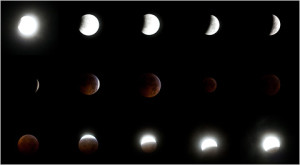For years I have attempted to convince my sons that “they” wanted a telescope for Christmas. Year after year, however, no telescope would be on their list for Santa. Finally they took the hint and about four years ago they gave me a telescope for Christmas. I admit that I do not use it that often – it is a bit cumbersome to carry and delicate to set up – but when I do I am not disappointed at what I see, even when it is at two o’clock in the morning.
Two o’clock in the morning is a time on my clock that I almost never see. It is too “late” for me to stay up and too “early” for me to start the day. Yet on Tuesday, at 2 AM Amy and I were awake and shivering in the front yard peering through my telescope. Yes, we were one of those eccentrics who actually got up to watch the lunar eclipse. This, as you have no doubt read by now, was not just any lunar eclipse. According to NASA this was the first time a total lunar eclipse occurred on the winter solstice since 1638. As a result, the moon appeared “very high in the night sky, as the solstice marks the time when Earth’s axial tilt is farthest away from the sun.” This will not happen again until 2094, and by then I will be 128 and my eyes will in all likelihood be too weak to view the eclipse!
The eclipsed moon reflected the earth’s own reflection of the sun rising and setting all over the globe, giving the moon a reddish appearance, like heated iron. Some call it the “Japanese Lantern.” It was a celestial marking of the winter solstice, the longest night of the year. By next week our days will have lengthened by several seconds! Ancient traditions marked this time as the “birth of the sun.”
There are a couple of theories of why Christians, somewhere around the fourth century, began celebrating the birth of Jesus near the winter solstice. December 25 falls nine months after March 25, the traditional date of the first day of creation. Jesus, therefore, reflects the birth of a new creation. Another tradition is dating the birth of John the Baptizer at June 24 (summer solstice) and for Jesus December 25 (winter solstice). Biblical evidence, however, suggests that historically Jesus was probably born between March and November when shepherds would be out in the fields. By 200 AD there were theories that Jesus was born on May 20 or April 20-21.
We really do not know when Jesus was born. We do know that His birth is our occasion for a celebration of a cosmic level. Just as the night will never be so long that the sun will not return, there is no journey in life that we will travel where our path is forever obscured in shadows. Christ has come, and Christ will come again.
Now that is something worth getting up in the middle of the night to celebrate!
Merry Christmas and peace on earth.


Recent Comments